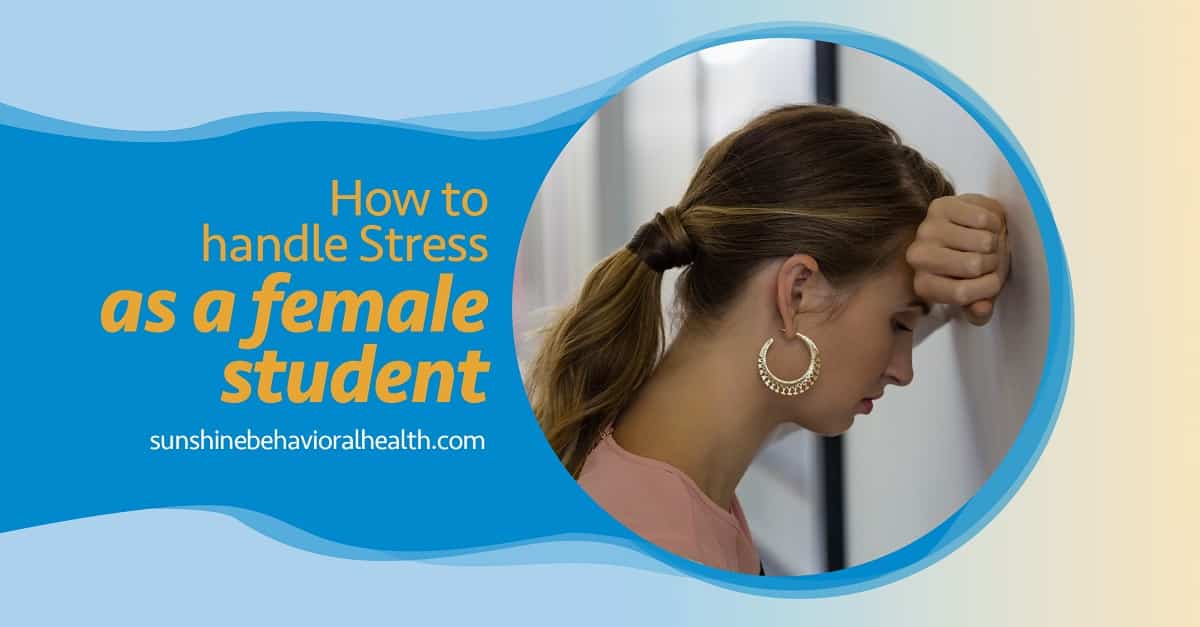
Suicide Prevention– Hotline: 800a273a8255
Crisis Text Line – Text 741741
Sexual Assault –Hotline: 800a656a4673
Domestic Violence- Hotline: 800a799a7233
NAMI – Helpline: 800a950a6264
SAMHSA – Hotline: 800a662a4357
Are you a female student who’s feeling stressed out? That’s understandable, because you’re probably extremely busy. You could be
Whew! Any one of those things can be stressful, and there’s a good chance that you’re experiencing more than one. You could also be facing other things that cause stress.
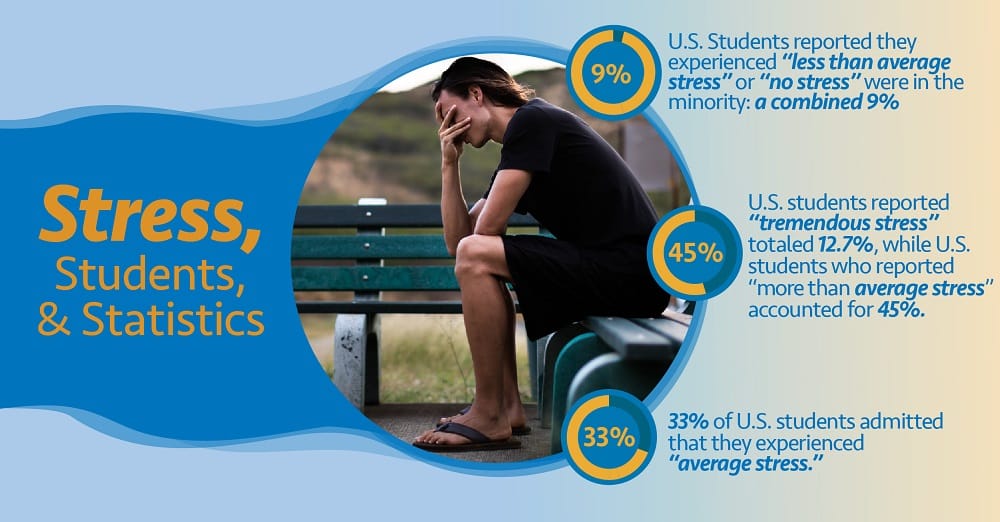
Stress and addiction are often linked. In fact, the two conditions may cause each other and make each other worse, so it’s important to treat both.
For example, a student could be stressed and anxious about one of her classes, so she might drink some beer or wine to relax. If she does this on a regular basis, she might associate alcohol with relaxation and feel as if nothing else can calm her.
Drinking regularly can eventually make the student tolerant. That is, she could become so accustomed to how alcohol makes her feel that she doesn’t feel its effects anymore.
She might drink more beer or wine to feel something. But after a while, she might stop feeling alcohol’s effects again, so she increases the amount that she drinks.
As this pattern continues, the student consumes more and more of a substance that can produce harmful physical and mental changes. At this point, alcohol probably isn’t soothing her stress. Instead, she could be anxious about her class, her drinking, and a growing number of alcohol-related problems.
Other times, college students might downplay their alcohol use.
They might associate college with experimenting with alcohol or drugs. Maybe they’ve seen movies or heard stories about wild college parties and think that drinking heavily or experimenting with drugs is what they’re supposed to do.
College students might drink or use drugs because they think that everyone else is doing it. They might feel that they need to do it to fit into social situations or relieve stress, but again, heavy alcohol and drug use often creates more stress, not less.
This use could create a cycle of stress – drinking – more stress – more drinking – that becomes increasingly dangerous the more it repeats.
If you’re struggling with stress or addiction, don’t be ashamed. Many people have had one or both of those problems. Many people have them now.
There’s also no shame in finding assistance to solve such problems. The fact that there are so many therapists, doctors, programs, treatment centers, support groups, and other options illustrates that many people need help and that many people are willing to provide it.
Are you stressed because of school and other things in your life? You’re not alone.
Researchers in a 2019 study noted that:
A 2015 survey by the American College Health Association revealed similar findings:
Stress is so common for female college students that one study even has the title “Stress in the Lives of College Women: ‘Lots to Do and Not Much Time.’”
Students and researchers have noted that many students face stress, but males and females might relate to stress in different ways.
When men experience stress, they may be more likely to express it in external, physical ways.
Females under stress may be more prone to doubt themselves. Compared to men, they may be more likely to internalize stress and may experience depression as a result.
But feeling stress isn’t a flaw and it isn’t your fault. It isn’t an internal failing. It’s a reaction to something external, something outside of yourself.
If we can’t change the external factor or factors that are stressing us out, we can alter the ways we react to them.
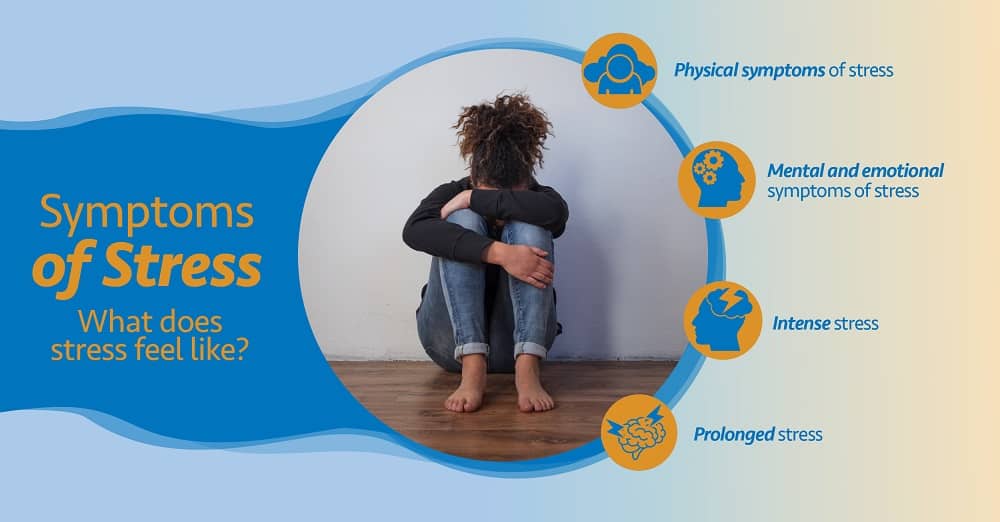 What does stress feel like? Well, it’s a condition that affects our bodies and our brains, so it affects a lot.
What does stress feel like? Well, it’s a condition that affects our bodies and our brains, so it affects a lot.
Some physical symptoms of stress are
Mental and emotional symptoms of stress might include
If we’re feeling intense stress for long periods of time, it could also affect our behavior. We might
Prolonged stress can also contribute to various medical conditions, including
There are also different kinds of stress.
Acute stress is a type of short-term stress that appears quickly but goes away after a short period of time. It might occur when we’re in danger (or we think we’re in danger) or in a new situation. We might feel acute stress when we’re taking a pop quiz, for example.
Chronic stress is prolonged and lasts for longer periods. We might experience this type of stress if a loved one is sick, if we’re grieving, or if we’re facing other long-term situations.
As harmful as stress can be, its effects are usually reversible. We have the power and tools to manage it.
College is full of changes. When we face change, sometimes we face stress.
Change and stress can be good. Change can help us learn and grow. A little stress can motivate us to do things.
But too much stress can cause physical and emotional reactions that can threaten our growth.
Exercise is one of the most effective ways to reduce stress and help improve our physical and mental health.
If you exercise already, you’re probably experiencing these benefits. If you don’t, and if you want to become more active, it might be easier to add movement to your schedule than you might think. You can:
You don’t have to exercise every day to see its benefits, and don’t give up if you skip a day or two.
Also, don’t criticize yourself for not exercising more. Some activity is better than none.
By moving a little more — or a lot more — you can ease your stress and feel better in general.
Did you know that some foods and beverages can provide mental benefits in addition to physical ones?
For example, if we’re feeling stressed, there are certain foods and beverages that can help us lower our anxiety and stress. We might consider eating or drinking:
Green tea has ingredients that may promote calmness, attention, and memory. It also has a fair amount of caffeine, which can help boost alertness, mood, and mental capabilities.
Both green tea and chamomile tea have antioxidants that can reduce inflammation. Antioxidants help protect the body from various diseases.
Stress can weaken our immune systems, so consuming items with antioxidants can provide protection when we’re feeling vulnerable. We can drink a hot, soothing cup of tea, add tea to a smoothie, and find this healthful ingredient in a growing number of products.
In addition to being a fun phrase to say, fatty fish such as salmon, sardines, mackerel, and herring are high in omega-3 fatty acids and vitamin D. Shellfish such as oysters also have both substances. Omega-3 fatty acids serve many functions in the body, such as providing energy.
Fatty, oily fishes also help the brain. Studies have found that people who consumed oily fish regularly were better able to handle stressful situations and had better visualization-based memory skills.
Another good thing about fatty, oily fish is that they also come in many forms, including fresh, smoked, and canned. This means that they’re accessible as well as nutritious.
Fish may not be everyone’s favorite food, but many people like chocolate. Dark chocolate can also affect our moods.
That’s because dark chocolate is another substance with antioxidants. These antioxidants can relax blood vessels, which can boost the body’s circulation while lowering its blood pressure.
Dark chocolate also includes substances such as tryptophan, which is an amino acid that could trigger the production of serotonin. Serotonin is a neurotransmitter, a substance that activates brain receptors and can make people feel good.
Foods with complex carbohydrates such as oatmeal could help relieve stress and provide energy. Other foods with complex carbohydrates include whole wheat bread, rice, cereals, foods with whole grains, corn, beans, peas, nuts, vegetables, and fruits.
Fiber and starch are complex carbohydrates and consist of long, complex chains of sugar molecules. Sugar, meanwhile, is a simple carbohydrate.
Complex carbohydrates
Eating such carbohydrates can help people fuller and calmer. The warmth of a bowl of oatmeal can also soothe people.
Breakfasts with protein can provide benefits when you consume them and for long afterward.
Protein can make you feel fuller and satisfied for a longer period of time. It can also help keep your blood sugar levels steady so you don’t feel shaky or anxious.
Adding foods such as eggs, yogurt, cheese, or peanut butter to your breakfast can also provide other psychological boosts. By eating breakfast, you’re proving that you’re taking care of yourself and are committed to starting the day in a health-conscious manner.
Consuming these items along with other nutritious food and beverages can help you reduce stress and anxiety and think more clearly.
In fact, a healthful diet, exercise, and various stress-reduction techniques can all improve your mental and physical health.
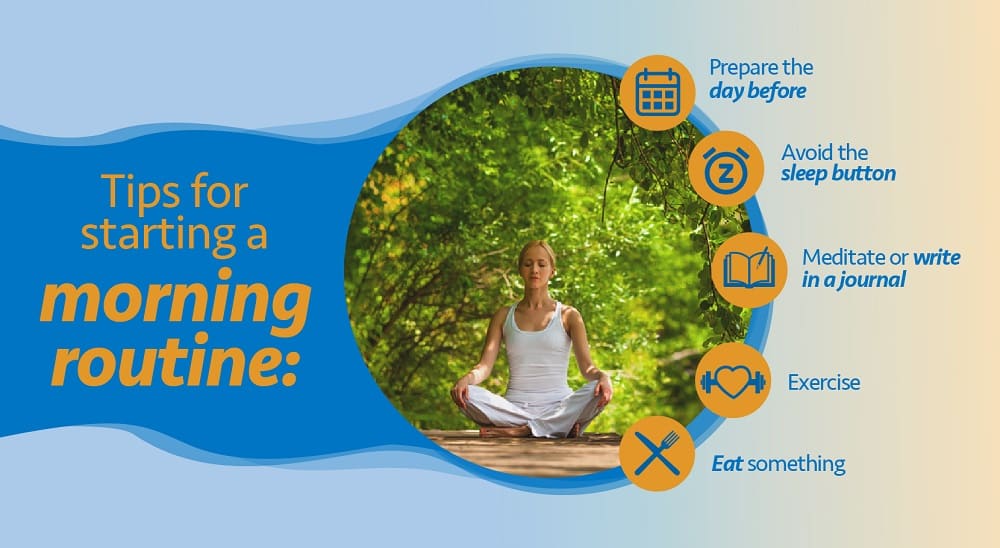
When we’re struggling with stress, we’re worried about uncertainty. So, wouldn’t it be a good idea to reduce uncertainty in any way we can?
A morning routine can help you do that. It can require you to do regular things at regular times.
Even if the rest of your day includes less structure, your morning routine can provide an oasis of calm. This calmness can help create a mindset that can help you face challenges with acceptance and confidence instead of anxiety and doubt.
To start a soothing morning routine, consider
Are mornings typically a time where you rush to get things done? If that’s the case, try to do things the day before to prepare:
Doing some things early will leave you fewer tasks to complete during your busy morning.
As much as you want those extra minutes of sleep, that extra time in bed might be doing more harm than good.
When you press the snooze button multiple times, you’re repeatedly falling asleep and waking up, which means that you’re constantly entering and leaving sleep cycles. This can leave you feeling tired and groggy, not exactly eager to start your day.
Instead, get out of bed when your alarm goes off the first time. You may be tired, but once you start moving, you may find that you have more energy compared to mornings when you relied on the snooze button. You might feel more alert and ready to tackle whatever comes your way.
Consider taking a few minutes to write some things in a journal or meditate for a bit.
Neither practice has to be formal or structured. If you’re writing in a journal, you can write what you’re feeling and reflect on something that makes you feel grateful. If you’re meditating, you can set a timer for five minutes, sit someplace comfortable, take deep breaths, and pay attention to those breaths.
Both practices encourage you to focus on the present moment. In stressful times, they can encourage relaxation and remind you of the good things in your life.
Moving around a little can get your body and brain in gear. Again, this doesn’t have to be an elaborate process.
You can do push-ups or abdominal crunches for twenty seconds, for example. To get your body and brain going, you can walk up and down a flight of stairs a few times or do a dozen jumping jacks. If you prefer exercise routines, you can visit a gym, purchase workout DVDs, or use exercise apps on your phone or computer.
Just do something, anything. Activity can boost our immunity, stimulate the brain, and elevate our moods.
Your whole life, people have probably been telling you about the importance of a good breakfast. Although it might be annoying, it turns out that they’re right.
Nutritious breakfasts can help prevent diabetes, obesity, and heart disease. After eating something, we feel fuller for longer, don’t experience fluctuations in blood sugar that can make us feel jittery, and can concentrate better.
If you can’t eat a large breakfast, try to eat a small one or a snack. String cheese, yogurt, and peanut butter sandwiches are filling sources of protein that are inexpensive and quick to prepare. They can give us focus and energy for hours.
Mornings can be hectic, even under the best of circumstances. If we’re experiencing stress, they might be harder to handle.
But by doing things regularly, we can create routines to soothe ourselves and accomplish things in the morning and throughout the rest of our day.
Stress can cause racing, distracting thoughts that could make life challenging.
We can calm these thoughts a little (or a lot) by writing in a journal, a practice also known as journaling.
Are you worried that journaling is adding one more item to your already long to-do list? Don’t worry, journaling doesn’t have to be a burden. It can be as simple as regularly jotting down a few sentences.
There are different types of journals and different techniques that can help you express yourself effectively:
When practicing expressive writing, take a set period of time, such as five, ten, or twenty minutes, to write about your emotions.
Writing about your emotions can help you express them without worrying about anyone judging them. If you’re expressing your emotions regularly, you can also start adding your thoughts, examining why you might be feeling certain emotions and determining what you want to do about them.
Adding your thoughts means that you’re processing your feelings. Instead of solely rehashing your emotions, you’re using them to think and to act.
Using positive affirmations can provide some structure to journaling. Positive statements can provide inspiration and motivation if you’re feeling depressed or stuck.
For example, you can think and write about the same positive quotation every day. Your different answers might illustrate your different emotions. Or, each time you write, you could complete certain sentences:
Keeping these journal entries and reading them later can help you determine what’s bothering you, what you did about it, and whether your circumstances have changed. A journal can help you track your growth.
In some ways, gratitude journals are similar to positive affirmation journals. Both encourage us to reflect on the positive things in our lives.
To contribute to our gratitude journal, for each entry, we can note at least one thing in our lives that makes us feel grateful. If we want, we can write more about why we’re grateful and describe our other emotions.
This means we could be combining a gratitude journal with one that features expressive writing. That’s okay. The structure of a journal doesn’t really matter. Writing regularly is more important.
While we might want to start a journal, we might not know how to begin. If we’re unsure, maybe we can start journaling by creating and contributing to a nonfiction journal.
Nonfiction journals can be factual accounts of what we did or what we considered the most important aspects of our days. When we start, we can say, “I did ______, then I did ______, and then I did ______.”
Like gratitude journals, nonfiction journals can become hybrid documents. We could begin by listing our activities, but as time goes on, we might find that we’re also writing about how these activities made us feel and how they relate to our pasts or futures.
It can be scary to think and talk about our feelings in a journal. If we don’t want to do those things directly, maybe we can write about them in fiction journals.
Instead of writing about ourselves, we could write about a character that we’ve created. This character could experience the same things we’re experiencing or think the same things we’ve been thinking.
By creating scenarios where the character interacts with other characters, we can explore how we might think and behave in similar situations ourselves. We can use these hypothetical situations to examine ways we can manage difficulties in positive ways.
Sometimes stress might seem so overwhelming that we don’t know what to do. Writing can help us examine what we’re thinking and feeling and find ways to deal with those thoughts and emotions, one sentence at a time.
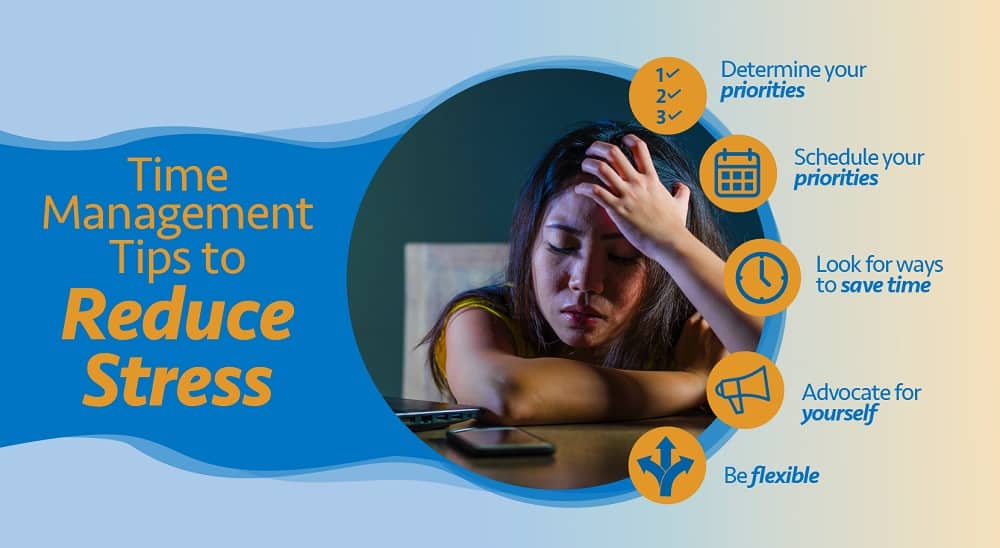
If you’re attending school, working, socializing, and doing other things, time is a precious commodity. You might be feeling stressed, wondering how you’re going to find the time to do everything you want to do.
While it’s obviously impossible to create more time, it is possible to maximize the most of the moments you do have. Time management tactics can help you accomplish things with less stress. You can:
Begin by determining what’s important to you and what’s necessary.
To do this, you can make two lists. On one list, write the things that you absolutely need to do, such as eating, sleeping, going to class, completing assignments, studying, and maybe working. On the other, list the things that you want to do.
Next, add all the things that you need to do to a schedule in a planner. It could be a planner on your phone or computer, a print planner, or a piece of paper with the days of the week written on it.
Unless your schedule’s insanely busy, you’ll probably have extra time in your planner. Use these spots to add the things that you’d like to do but don’t absolutely need to do.
Typing or writing your tasks and scheduling them in a planner can help you see what you actually do. They can help you figure out how long tasks take to complete and whether you want to spend more or less time on them.
As an added bonus, a written record could help you remember to do certain things. Win-win!
When you look at your lists, are there places where you can save time? Can you combine some of the tasks?
For example, if you want to socialize, maybe you could meet your friends to go for a walk and get some exercise at the same time. You could schedule a time where you and your friends can go grocery shopping together and share a meal before or after.
You could also determine if you need to complete all the items on your lists yourself. Can you ask someone to help you complete tasks while you help them with theirs? Some assistance can help lighten everyone’s burdens.
On the other hand, you might not have time to do everything that other people ask, so practice saying no. People can’t be everything or do everything, so learning how to decline unnecessary tasks can save time and prevent stress.
To do that, you can politely decline someone’s request. You can thank the person for thinking of you, but say that you just can’t complete their request at this time.
At the same time, you might want to show the person requesting your assistance what you’re already doing. This shows the person that you’re truly busy and have a good reason for declining.
Remember that life happens in spite of schedules. You might become sick, work additional hours to cover for a coworker, or have an unexpected school project, so what you’ve planned might be different from what you’re actually doing.
If that happens, you can make a new schedule. If you’re sick, you can add time for rest and recuperation to your planner. You might find that you have less time for the things you want to do because you’re busy finishing the things you need to complete.
During these times, you might especially want to ask for outside assistance. Many relatives and friends are eager to help a loved one in need, and you can do the same for them in similar circumstances.
Understanding what you need to do, scheduling it, and enlisting others for assistance can help you manage time and experience less stress.
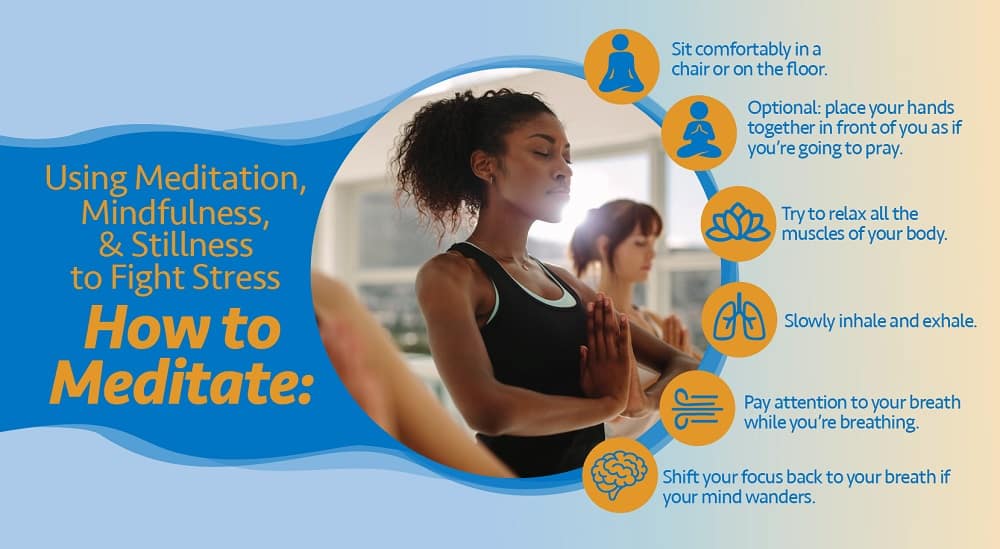 Did you know that you can use mindfulness, stillness, and meditation to help fight stress?
Did you know that you can use mindfulness, stillness, and meditation to help fight stress?
You can.
Of course, when you’re stressed, stillness and meditation might sound difficult.
You might feel as if you have so much to do and don’t have the time to meditate. You might feel as if it’s impossible to be still because so many thoughts are racing through your head.
But you don’t have to devote an hour each day to meditation and you don’t have to clear all your thoughts to find relaxation. Instead, you can do a few easy things.
Although there are different types of meditation, you don’t need to create an elaborate, formal routine to practice meditation and stillness. Consider doing these things:
During your breathing exercises, if you think of something other than your breathing, don’t judge the thought or yourself for thinking it.
Just keep breathing, noticing any thoughts but not attaching any feelings to them, and focusing on your breathing again.
Consider meditating like this twice a day for at least ten minutes and gradually adding time.
But if you can’t commit to that, don’t worry. Adding stress-relief routines to your schedule shouldn’t cause you more stress.
Can you meditate once a day for ten minutes? That works. Or consider practicing these breathing exercises for a few minutes when you wake up or when you go to bed.
If you’re particularly stressed, you can squeeze a quick meditation session into your day by sitting and focusing on your breathing.
Meditation is a practice that promotes mindfulness. Mindfulness encourages us to be aware of what’s going on around us and what we’re thinking and feeling in the present moment.
This can be especially useful in stressful situations. If we’re thinking about the present, it gives us less time and energy to dwell on the past or worry about the future.
Using meditation to practice mindfulness can reduce your anxiety and can provide other benefits, such as reducing your blood pressure. It can give you a rest and add some stillness to a busy day.
Medical disclaimer:
Sunshine Behavioral Health strives to help people who are facing substance abuse, addiction, mental health disorders, or a combination of these conditions. It does this by providing compassionate care and evidence-based content that addresses health, treatment, and recovery.
Licensed medical professionals review material we publish on our site. The material is not a substitute for qualified medical diagnoses, treatment, or advice. It should not be used to replace the suggestions of your personal physician or other health care professionals.